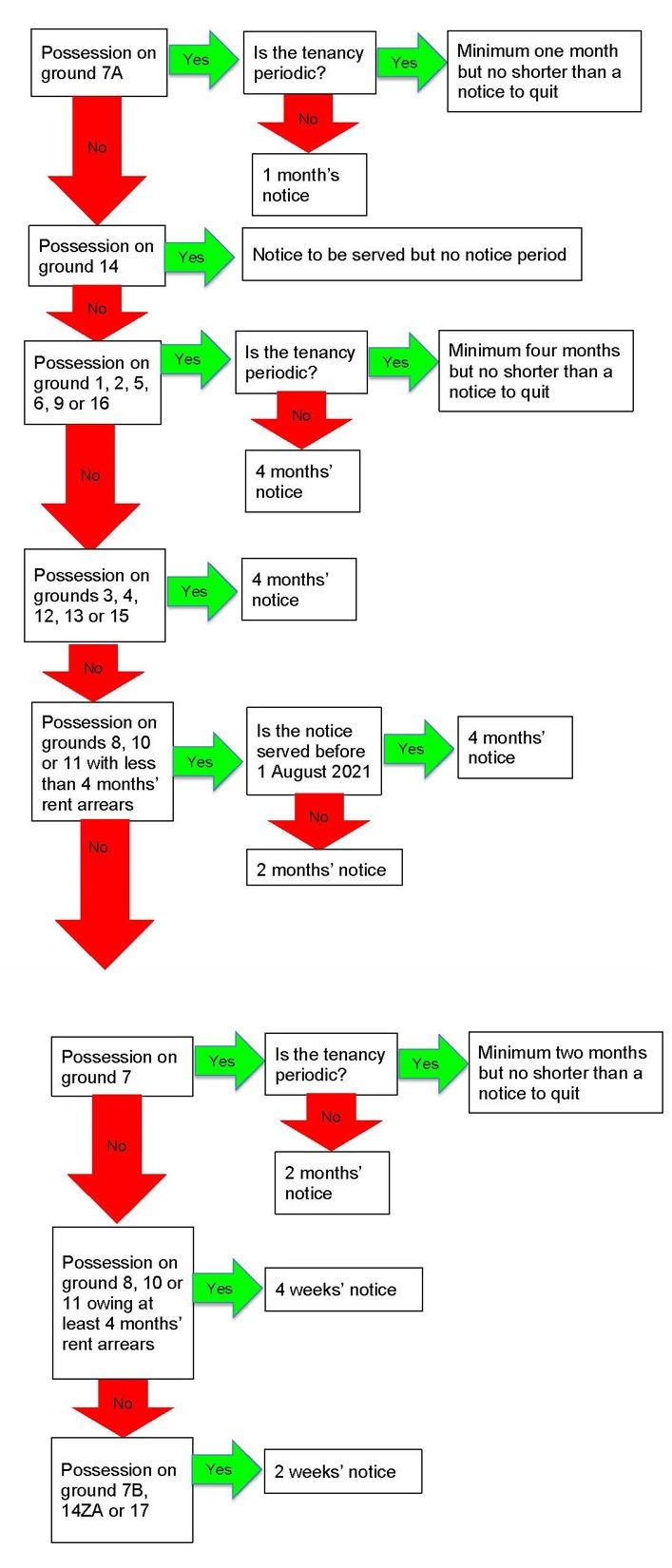
The lifting of the tenant eviction ban on 1 June has come and gone and, across England at least, landlords are looking forward to being able to start pursuing possession claims. Some simply needed the bailiffs to start working again, whilst other may now want to start the notice process. Indeed, many might have held off serving notice since the announcement earlier in May that notice periods would reduce from six months to four months for most notices in England.
However, it is not quite as simple as that as not all notices have changed the length and if a section 8 notice is used, the combination of grounds can have a profound effect on the length of the notice.
Starting with the simple point, section 21 in most cases will fall from a minimum six months to a minimum four months. We say ‘minimum’ as if the rent was payable six monthly or annually then at least six months’ notice would still be required. The period in which court proceedings must be started also drops from ten months to eight.
Section 8 is much more complex as each ground has its own ‘length of notice’, but additionally the combination of grounds can change that length. The three rent arrears grounds have even more complex rules, depending on the amount of the arrears and when the notice is served. Indeed, in some cases of rent arrears there is little point in serving notice till August.
With all this complexity Training for Professionals have designed and provided a flow chart with simple questions about which grounds are being used and clear instructions about how long the notice will therefore have to be. You simply start in the top left corner and answer the first question Yes or No and follow the flow. We have also produced a 30 minute webinar talking you through the flowchart and providing practical examples.
For example, and using ground 8, 10 and 11 to illustrate, if the day you are serving notice there is less than four months of rent arrears, then today you have to give four months’ notice. If you wait till 1 August and serve the same notice it only has to be two months long. This gives a small advantage today but as time progresses the benefit will increase. Just to clarify one common confusion the Coronavirus Act did not change ground 8 only needing two months of rent to be ‘lawfully due and unpaid’. Therefore, if rent is due the 1 May and not paid and then due again on the 1 June and not paid, on 2 June you can serve your section 8 notice seeking possession on ground 8 (and probably including grounds 10 and 11 too). However today, because the total arrears are less than four months of arrears the notice will have to be four months long.
The trick is to find the best combination of grounds to give the best notice period and outcome. For example, a tenant owing two months of rent and the landlord also wants to move back into the property, could use ground 8, 10 and 11 for the rent and ground 1 for the owner occupier. However, depending on the level of the rent arrears, this might increase a four week notice to being a four month notice. Clearly this is not attractive. On the opposite side of the coin, if the tenant owes two months of rent arrears and you have had complaints from the neighbours or police about anti-social behaviour, this could reduce four months’ notice to no notice period at all. The flow chart and webinar guides you through all these permutations.
As an agent you may have a policy of not serving notice on behalf of the landlord. However, it is still important to understand these rules so that you can provide the right information and advice. For example, if the landlord asks you to send the rent account details to the solicitor for a possession action, if you understand that the neighbours’ complaints are relevant you might include that information so that the solicitor can decide if it is appropriate to include that information too.
Note that the changes introduced on the 1 June change again slightly on the 1 August (rent arrears of less than four months drops from four months’ notice to two months’ notice) and are expected to end on the 1 October, Coronavirus permitting!
David D’Orton Gibson is managing director of Training for Professionals.



Thank you that is a very handy flow chart
You must be logged in to like or dislike this comments.
Click to login
Don't have an account? Click here to register
Well said, this is very good.
You must be logged in to like or dislike this comments.
Click to login
Don't have an account? Click here to register
You must be logged in to like or dislike this comments.
Click to login
Don't have an account? Click here to register
I wonder if anyone reading, could do the equivalent for Wales? That would be very helpful.
You must be logged in to like or dislike this comments.
Click to login
Don't have an account? Click here to register
Hi Ros we are planning to do one for Wales. We did not do it at the same time because this reflects the revised rules that came in from the end of May in England. The rules in Wales were not due to change till the end of June and at the time this was drafted Wales had not announced their new rules. They have now confirmed that the rules in Wales will not change at the end of June, as had been planned, but will continue as they are today till September. The rules in Wales are a little simpler as they have not included serious rent arrears in the list with a shorter notice period and they don’t have the change that happens in England on the 1 August. Still, we will work on the one for Wales now and revise it as the rules change. All the best.
You must be logged in to like or dislike this comments.
Click to login
Don't have an account? Click here to register
Hi RosBeck73
I have now produced the Welsh version, thankfully much simpler, of the section 8 flowchart.
If you would like me to email you a copy you can find a contact email address on our website, just Google “Training for Professionals”, and ask for a copy of the Welsh section 8 flowchart.
You must be logged in to like or dislike this comments.
Click to login
Don't have an account? Click here to register
David has been a foundation stone of lettings and property management for over 20 years now. I have never heard complaint or criticism of the service he offers.
Whenever I read Facebook self help groups wondering about the basics of letting and management I really wonder why the agents requesting help don’t simply subscribe to Training for Professionals and get the support and advice they need. TFP really is the most reliable and cost effective way of making sure agents are getting it right.
You must be logged in to like or dislike this comments.
Click to login
Don't have an account? Click here to register
Agree….
The most knowledgeable guy in lettings I know. Had the pleasure of learning from the master for almost 5 years.
You must be logged in to like or dislike this comments.
Click to login
Don't have an account? Click here to register
With S21 and the AST to be abolished one wonders how S8 will be an effective process to remove feckless tenants.
Even a revised process will surely be dysfunctional even if returning to the original S8 process.
Most LL could use the original S8 process as most LL are seeking repossession due to their feckless tenants defaulting on rent for WHATEVER reason.
However all LL know how tenants can game the S8 process.
All they need to do is reduce rent arrears to 1 month.
Then the LL has to start the S8 process all over.
A tenant can keep this rent defaulting situation up for years providing on the day of a S8 court hearing they reduce the rent arrears to 1 month.
Tenants game the S8 process which is why LL use the current S21 process.
County Court fees for every new S8 process are very costly.
Using S21 when available avoids the situation of multiple and very costly for the LL S8 hearings.
Unless a revised S8 process is introduced to replace S21 LL will face extreme difficulty and cost in getting rid feckless rent defaulting tenants.
Effectively a LL would need to pay fees everytime they initiate a new S8 process.
That could be 6 per year if the rent defaulting tenant games the S8 process correctly.
LL will be further prevented from repossession.
Time for LL to stop letting on an AST basis.
You must be logged in to like or dislike this comments.
Click to login
Don't have an account? Click here to register
The actual plan involves abolishing the AST, not just removing the section 21. This was evident from the consultation.
The plan does include change to grounds for possession and critical for landlords will be the details of both that change and any new process for the court.
We always teach that when serving section 8 for ground 8 rent arrears, always include 10 and, if true, 11 for persistent late payment. If the tenant pays off to a penny less than two months arrears for ground 8 you can still either get a possession order based on 10 and 11, even if a suspended order saying the tenant must keep up to date with the rent or the landlord can apply for the bailiffs. Would also be worth asking for at least possession suspended on the basis the tenant pays the court application fee. After having to pay the £350 plus court fee plus any rent due it may be a less attractive option.
There is no doubt these changes are not to attract landlords to invest, their only interest is to help tenants. It is stated policy that they want less private landlords and more institutional investors, whom they believe make better landlords.
You must be logged in to like or dislike this comments.
Click to login
Don't have an account? Click here to register
Yep I get what you accurately state about the nuances of S8.
I DON’T believe many LL including me are aware of theses nuances.
It is my contention that DJ will ignore these nuances and continue to allow tenants to game the S8 process.
I simply cannot see an enhanced S8 process equaling the S21 one otherwise what would be the point!?
But essentially I totally agree with your contentions that all these revised processes are designed to get rid of small LL.
Not much such LL can do about it apart from vote with their feet out of the AST PRS especially to single households.
HMO AST at least give LL a fighting chance to service mortgage debts etc.
Surely not all HMO occupiers will rent default all at once!!!??
You must be logged in to like or dislike this comments.
Click to login
Don't have an account? Click here to register